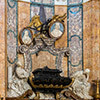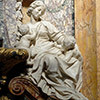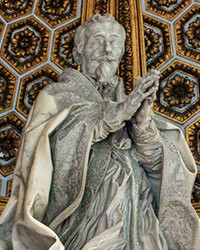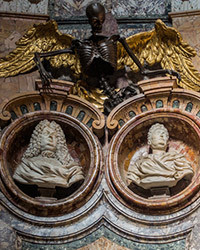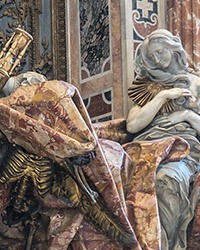The Rospigliosi-Pallavicini Chapel – the posthumous chord of a great Roman dynasty
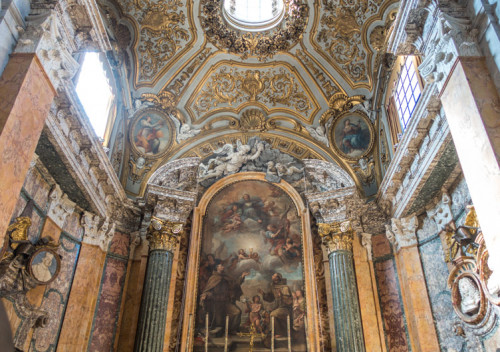
Rospigliosi-Pallavicini Chapel, Church of San Francesco a Ripa

Tombstone of Stefano and Lazzaro Pallavicini, Church of San Francesco a Ripa
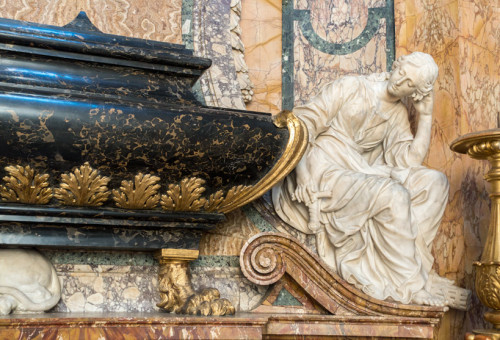
Tombstone of Stefano and Lazzaro Pallavicini, allegory of Fortitude, Church of San Francesco a Ripa
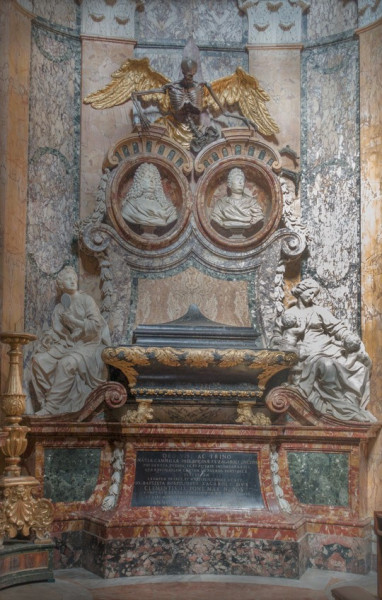
Tombstone of Maria Camilla and Giambattista Rospigliosi-Pallavicini, Church of San Francesco a Ripa
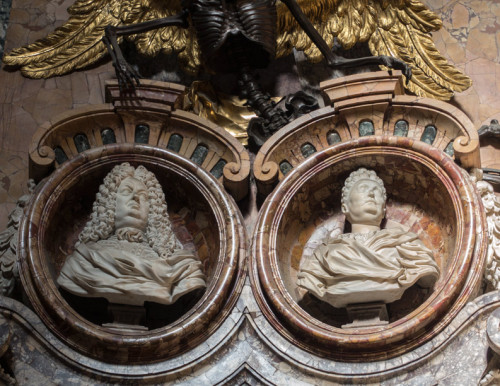
Tombstone of Camilla and Giambattista Rospigliosi-Pallavicini, fragment, Church of San Francesco a Ripa

Tombstone of Camilla and Gianbattista Rospigliosi-Pallavicini, allegory of Mercy, Church of San Francesco a Ripa
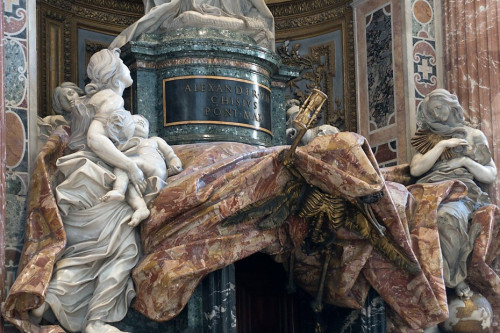
Funerary monument of Pope Alexander VII, allegory of Mercy and Truth, designed by Gian Lorenzo Bernini, Basilica of San Pietro in Vaticano
Multi-colored marbles, gilded stuccos, and exquisite wall intarsias – this is the appearance of one of the chapels of the Church of San Francesco a Ripa. And although this church is mainly known for the masterpiece chiseled by Gian Lorenzo Bernini, we can be sure that the richness of the burial site of one of the greatest Roman families, the Rospigliosi-Pallavicini will also take away our breath. For centuries, the posthumous chapel was one of the principal methods of self-presenting a family in a public location – an integral part showing its significance and prestige. And this was also the case here, although there was also something else involved: the commemoration of a thirty-year alliance between two families, which at that very moment was once again falling apart.
Multi-colored marbles, gilded stuccos, and exquisite wall intarsias – this is the appearance of one of the chapels of the Church of San Francesco a Ripa. And although this church is mainly known for the masterpiece chiseled by Gian Lorenzo Bernini, we can be sure that the richness of the burial site of one of the greatest Roman families, the Rospigliosi-Pallavicini will also take away our breath. For centuries, the posthumous chapel was one of the principal methods of self-presenting a family in a public location – an integral part showing its significance and prestige. And this was also the case here, although there was also something else involved: the commemoration of a thirty-year alliance between two families, which at that very moment was once again falling apart.
Three years prior to her death the venerable Maria Camilla Rospigliosi-Pallavicini in her will, obliged her heirs to finish the family chapel which she funded. She died in 1710 at the age of sixty-five, at a time when the works one the chapel were just beginning. Things picked up thanks to Giuseppe Mazzuoli, an artist who was entrusted with creating the sculpting decorations, and who was brought to Rome from Siena, as well as the architect Nicola Michetti.
The story of Maria Camilla and her husband Giovanni Battista (Giambattista) Rospigliosi must begin many years prior – in 1670, when this nephew of Pope Clement IX married (reportedly against his will) the rather pedestrian-looking (as chroniclers would have us believe), but extremely wealthy daughter of the Pallavicini family. The dowry of the bride equaled one million scudos, and in addition, there were properties which she would inherit after the death of her father and uncle. Maria Camilla was the only heir of her family, just as Gian Battista was the last of the Rospigliosi family. Their joining in holy matrimony allowed for the establishment of the power of a new dynasty – powerful thanks to the pope’s support as well as the wealth of bankers from Genoa. During their life together the couple became known for its widespread artistic patronage, a rich art gallery, and an imposing palace (Palazzo Rospigliosi-Pallavicini) built on Quirinale Hill. The idea of an appropriate posthumous chapel came about in time as something natural.
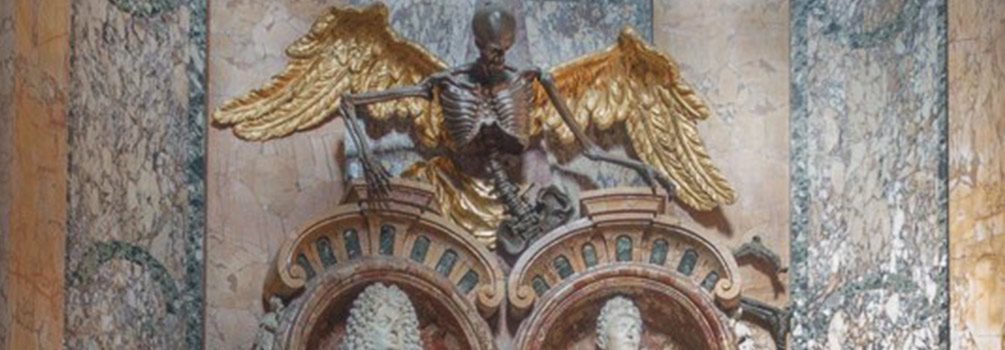
We may ask, why was it the church on the Trastevere that was chosen by this family to immortalize themselves. The reason was Maria Camilla’s uncle – Cardinal Lazzaro Pallavicini, who prior to his death (1680) modernized and renovated the Church of San Francesco a Ripa, in this way gaining the gratitude of the Franciscans who resided there, as well as a representative location in the transept of the building, designated for a chapel. Its founder desired to commemorate her uncle the cardinal, as well as her father – Stefano Pallavicini. Their images made in relief can be found on the left side of the chapel. They are accompanied by two statues seated below of the allegories of Justice and Fortitude. On the other side, we will notice the bust of Maria Camilla and her husband (who had died twelve years after her). They are also accompanied by allegories – this time Charity and Prudence. Maria was depicted with coiffed curls. Her rather puffed-up face with a wide chin and folds of wrinkles around her mouth as well as bags under her eyes is a testimony to utter abandonment of idealization. Her husband can be similarly characterized. The lavish, typical for the time period wig surrounds the full face of Giambattista, while the wrinkles above the forehead add determination and strength. Both of them appear proud and powerful, which probably was the main task which the sculptor faced.
Works on the chapel were continued by Giambattista Rospigliosi-Pallavicini all the way until his death in 1722. At that moment based on the will of his wife and a mutual agreement, the surname, as well as the wealth, were once again divided between their two sons. The elder acquired one half and the Rospigliosi surname, the younger the other half and the Pallavicini surname. They both received nearly equal shares. The daughters were also well taken care of. It is worth adding that the appropriate clause in the will forbade all attempts at questioning the last will of Maria Camilla and her husband.
The authors of the design of the chapel were architects Nicola Michetti and after him Ludovico Rusconi Sassi. The sculpting decoration as was already mentioned was completed by the skilled student and the successor of Gian Lorenzo Bernini – Giuseppe Mazzuoli. This artist left several works in Rome, including the monumental figure of St. Phillip in the nave of the Basilica of San Giovanni in Laterano. The winged skeletons made out of bronze (the work of Michele Garfolino), adorning both the sarcophaguses, are a reminiscence of the magnificent skeleton from the funerary monument of Pope Alexander VII, which Mazzuoli also helped create forty years earlier, completing (according to Bernini’s design) the allegory of Charity. It is interesting to compare it with the one which he completed in the Rospigliosi-Pallavicini Chapel. We can note a definite calmness of gestures of the created personification, but also a distinctly "calmed" pose of a woman in comparison with the older one – energetic and full of life. The work of the over-sixty-year-old sculptor is, as it would seem, sensible and elegant. However, it is not about the maturity of the artist. The sculptures, which Mazzuoli created in the chapel, are seemingly a recalling of an era, which was slowly coming to an end. His allegories as opposed to those created by his master, are not only clothed from top to bottom but also – despite the great number of folds covering them – calm. There is a distinct melancholy coming from them, which is an evidence of new tendencies in Roman art – striving to balance out emotions, but also towards much simpler forms. Mazzuoli is still under the influence of his great master, Bernini, however his nephew (also a sculptor) Bartolomeo Mazzuoli will definitely be drawn towards Classicism.
The altar in the chapel is adorned by the painting of Giuseppe Bartolomeo Chiari. It represents two saint Franciscans and patrons of the chapel: Peter of Alcántara and Paschal Baylòn. Chiari also created the painting on the vault.
Works on the decoration of the chapel, filled with diverse, colorful marbles, gilded stuccos, and bronze fittings stretched all the way to 1730 when two heirs, Clemente Dominico Rospigliosi and Nicolo Maria Pallavicini paid the last bills. However, despite the fact that no money and efforts were spared in arranging the chapel with lavishness and riches fit for palace interiors it is still missing something. However, everyone can see it for himself when he stumbles here by accident (definitely must do so!) in the search for the famous Statue of the Blessed Ludovica Albertoni made by Bernini, which is found in the tiny (in comparison with the one described) chapel nearby.









